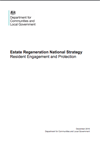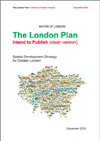Handouts
Below are some resources for tenants and residents facing the redevelopment of their estates. Feel free to use them on your estate as they are, or copy the content to use in your own newsletters or campaigning factsheets.

Know your rights
Community groups and residents associations have long fought for their rights to a fair treatment and this has resulted in some important positive changes to policy. Below you find the most important policy documents, which pin down tenants and leaseholders rights to be treated with fairness.

The London Mayor’s Better Homes for Local People, published in 2018, focuses on ensuring that tenants and residents have been properly consulted on regeneration proposals for their estates, that council / social housing is not being lost and tenants and leaseholders are not displaced in these schemes, which has often occurred across London.
Key points in the Mayor’s guidance are:
- Alternatives to demolition of social housing should always be considered first in estate regeneration schemes.
- If demolition is chosen, ‘affordable’ homes should at least be replaced on a like-for-like basis, and increased wherever possible. That means that new social rented homes should be the same rent levels as existing.
- Where the cost of this like-for-like replacement would make an estate regeneration scheme financially unviable, gap funding should be sought from the Greater London Authority (GLA).
- A ballot of tenants and residents is now a condition of funding from the GLA for estate regeneration schemes where demolition is proposed and where at least 150 new homes are to be built. Some exemptions exist to the Ballot Resident Requirement and can be viewed in this document by the GLA.
- In instances where demolition and replacement of existing homes occurs, social tenants should be guaranteed full rights to return (or to remain through a single move). Leaseholders and freeholders must be offered a fair deal.
- Tenants and residents must be at the heart of decisions about the ongoing management and the future of their estates. In respect of estate regeneration landlords must also seek to consult with private tenants, those living in temporary accommodation on the estate and non-resident leaseholders and freeholders.
- Councils and housing associations should also engage with Tenant and ResidentAssociations (TRAs), or similar resident representative bodies, where they exist.
- Consultation must be transparent, extensive, responsive (to the views of tenants and residents) and meaningful.
- Resident Charters, setting out landlord’s commitments to residents at an early stage of discussions can be an effective way to engage residents. Commitments in a charter should be clear, specific, deliverable, and written in accessible, non-technical language.
- Residents should be closely involved in shaping the estate regeneration priorities and options for achieving them. Options appraisals should be open and transparent. They should include technical and financial appraisals that have influenced any decisions on the options. They should also be set out in an accessible format with non-technical summaries. Any options that have been discounted (as unviable or undeliverable) should be made clear with a clear explanation of why.
The offer made to tenants and leaseholders should include:
- Social tenants who have to move as a result of estate regeneration plans, either through a single move or a temporary move off the estate, should have a full right to a property of a suitable size, at the same or similar rent level and with the same security of tenure on the regenerated estate.
- Where tenants have to move temporarily to a new home as a result of estate regeneration,they should be awarded high priority in the local allocations policy.
- Landlords should seek to offer the maximum home loss compensation permitted to tenants who meet the statutory criteria and who are displaced from their homes due to estate regeneration.
- Landlords should pay for the ‘disturbance costs’ of moving home. That is reasonable costs such as: removal and telephone and utility connection costs(including installation of appliances) and provision of new carpets and curtains.Tenants who must move more than once should receive home loss payments for each move.
- Private tenants on estates being considered for regeneration must be made aware of their options and rights, including signposting them towards other housing options or rights under homelessness legislation.
- Additional support and assistance should be offered to vulnerable households, regardless of their tenure. This could be for those want to move out of the area or into specialist housing. Councils and housing associations should make reasonable endeavours to meet these requirements.
- Where councils or housing associations propose to let homes on short-term tenancies,they should ensure that new tenants are fully informed about any plans to regenerate the estate and that they are aware of their rights, including how they differ from those of secure tenants.
- Where it is necessary to acquire leaseholders and freeholders’ homes, landlords should first seek to do this by negotiation. Market value (plus home-loss payments where appropriate) should initially be offered, in good faith.Where compulsory purchase is required, this should be based on a value of the home assessed by an independent valuer and paid for by the landlord if requested by the leaseholder or freeholder. The valuation must reflect the value of the property before the impact of regeneration or proposed regeneration.
- Positive consideration should be given to resident leaseholders and freeholders to combine market value and home loss payments towards the purchase price of a new home. Some resident leaseholders may have very little experience of buying a home outside the Right to Buy process and should be offered assistance throughout any process of buying a new home.Councils and housing associations should offer resident leaseholders and freeholders the right to a new home on the regenerated estate via: (a) a shared equity basis, where the resident leaseholder or freeholder owns a proportion of the new home equivalent to the market value of the property that they gave up, with no rent payable on the remaining ‘unsold’ share. They should be allowed to retain any uplift in the value of their share of the new property between the point of purchase and any eventual sale; or (b) a shared ownership basis, where the resident leaseholder or freeholder owns a share of a new affordable home, is able to increase the share owned over time, and may pay rent on the remaining share to the council or housing association in the meantime.
Full right to return or remain for social tenants
A fair deal for leaseholders and freeholders

This document sets out how developers, landlords and local authorities should engage with residents throughout an estate regeneration scheme and how affected residents should be protected.
Key principles are:
- EARLY AND ONGOING ENGAGEMENT
- ENSURING RESIDENTS SUPPORT
- PROTECTION FOR RESIDENTS
- MINIMISING DISRUPTION AND MAINTAINING COMMUNITY TIES
- RESIDENTS’ INVOLVEMENT IN THE MANAGEMENT OF THE ESTATE
A collaborative approach to regenerating the estate needs to be created, so that the residents are considered key partners throughout the process including developing the vision, initial decisions, options appraisal, design, procurement and delivery of schemes. To enable effective participation, training should be made available for residents. Where residents need to assess options, all financial and other information should be made available to them. Plans and business cases should be available in an accessible format in non-technical language.
All approaches to regeneration should have the support of a majority of the residents whose lives will be affected by the scheme. Residents and the wider community should have a say at the milestone stages where there are choices to be made. Where Neighbourhood Plans exist or are in development, these should be taken into account in all discussions. A vote may be appropriate before complete demolition, whereas workshops or surveys could be used to communicate views about partial demolition or refurbishment.
A residents’ charter should be developed in collaboration with residents as early as possible in the process. This should include specific tenant rights, residents’ entitlements for home loss and disturbance payments, and opportunities for shared ownership and equity. All existing council and housing association tenants, whether on a lifetime or fixed-term tenancy, should have the option to return to the estate, alongside at least two other housing options which address their needs.
It is a legal requirement for leaseholders to be compensated if their home is demolished. However, it is expected that schemes will go further and offer leaseholders a package that enables them to stay on the estate or close by. Leaseholders should also be offered the option of an independent valuation of their property.
Home purchase options could include shared ownership (if the percentage payable in rent is affordable) or an equity stake with alternative funding approaches to address the gap including compensation payments to mitigate the risk of displacement from the neighbourhood. Learn more about the definitions of models for resident offer in Annex B.
The regeneration process should be carefully planned so that community ties are not undermined. The aim should be to move residents only once, from their existing home to a new home on the estate. This usually requires a phased approach to regeneration. In particular, consideration should be given to how elderly and disabled people, families with young children and residents with strong religious and cultural ties will be able to maintain their support networks.
The ongoing management of the estate is vital to its sustainability. Residents should have the opportunity to participate in the ongoing management of the regenerated estate. In some cases this may be through a formal tenant or resident management organisation or through a resident-led board. Where elected or self-selected residents represent the estate, landlords should provide them with the resources to communicate and engage with all residents to ensure their representative approach is inclusive.

The London Plan is produced by the Mayor of London and sets out strategic policy for the whole of the city. It must be taken into account in the decision making of London Boroughs. The new London Plan, soon to be adopted (as at June 2020), has a policy H8 Loss of existing housing and estate redevelopment. Parts C, D and E of this policy are particularly relevant and you can read them in full below.
What the London Plan policy says:
- Look at alternative options before considering demolition
- Weigh up the social and environmental impacts
- If the redevelopment is funded by the Mayor, there are conditions to follow
- A significant amount of the replacement affordable housing could be London Affordable Rent, which is much more expensive
What the London Plan policy does NOT say:
- No mention of refurbishment or keeping existing homes and community
- No mention of ballots or engagement with tenants and residents
- No right to remain as council tenants and no guarantee that your housing costs will remain the same (e.g housing association rents are higher than council rents and service charges could be much higher after redevelopment).
London Tenants Federation, Just Space and other community organisations took part in the public examination of the new London Plan in 2019 and raised these problems. We pointed out that the loss of council housing and displacement of communities would continue much as before under this policy.
H8 Loss of existing housing and estate redevelopment
- C- Before considering the demolition and replacement of affordable homes, boroughs, housing associations and their partners should always consider alternative options first. They should balance the potential benefits of demolition and rebuilding of homes against the wider social and environmental impacts and consider the availability of Mayoral funding and any conditions attached to that funding.
- D- Demolition of affordable housing, including where it is part of an estate redevelopment programme, should not be permitted unless it is replaced by an equivalent amount of affordable housing floorspace. Affordable housing that is replacing social rent housing must be provided as social rent housing where it is facilitating a right of return for existing tenants. Where affordable housing that is replacing social rent housing is not facilitating a right of return, it may be provided as either social rent or London Affordable Rent housing. Replacement affordable housing should be integrated into the development to ensure mixed and inclusive communities.
- E- All development proposals that include the demolition and replacement of affordable housing are required to follow the Viability Tested Route and should seek to provide an uplift in affordable housing in addition to the replacement affordable housing floorspace.





